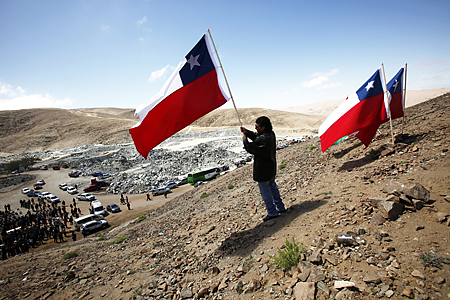
Chilean miner Claudio Yanez, one of the 'Atacama's 33', waves a national flag during a tribute to commemorate the first anniversary of the rescue of 33 miners in Copiapo, Chile, October 13, 2011. (Photo: Felipe Trueba / EFE / Zuma)
It was Chile’s own man-on-the-moon moment. In fact, for those of us who were there, last year’s miraculous rescue of 33 trapped Chilean miners seemed in some ways eerily, wonderfully similar to a moonwalk. It played out in the cold dead of night on a remote and rocky desert landscape that might as well have been the lunar surface. The narrow, specially built capsule that brought the men up from 2,300 feet (700 m) below the earth seemed as daring a contraption as an Apollo module. The large, dark sunglasses they wore hid their eyes like space helmet visors. A billion people the world over watched the feat on television.
A lot has come crashing down to earth in the intervening year, for the rescued and rescuers alike. Thursday, Oct. 13, a first-anniversary commemoration of the rescue operation was held at the site of the San José gold and copper mine near Copiapó, in Chile’s northern Atacama Desert. It was there that los 33 had spent 70 days underground after the mine’s collapse – the first 17 of those days struggling to stay alive before authorities located them. But amidst yesterday’s celebration, it was hard to ignore the fact that many of the miners’ post-rescue expectations have since caved in as well – and it was even harder to disregard it as news spread that one of the men, Carlos Mamani, 26, wasn’t there because he’d been arrested in Copiapó the night before on domestic violence charges, according to the Santiago daily El Mercurio.
(SEE: Pictures of the miners being brought to safety.)
Mamani’s troubles simply add to the litany of difficulties, from the psychological to the financial, that Chile’s miner heroes have wrestled with since their globally hailed triumph. Some of those problems were expected and were evident just weeks after the rescue, when los 33 met with TIME for our 2010 Person of the Year issue. Though still spiritually ebullient from having beaten death as bravely and resourcefully as they did – “I want to tell young people to take advantage of this life,” Mamani told us then, “to see how beautiful it is to be alive every minute that goes by” – most complained of having troubles sleeping at night. Others groused about not having enough money to address health concerns like the gum disease some contracted below ground.
The issues have increased in the meantime. Many of the miners, like shift leaders Luis Urzúa and Mario Sepúlveda, have adjusted well. But others, like Edison Peña, 35, the long-distance runner who sang Elvis songs on Letterman last year, have had to seek psychiatric help for conditions ranging from the sleeplessness to more serious, post-traumatic stress-style disorders. Not surprisingly, unemployment is another common malady. That’s a particularly jolting reality check not only after months of being welcomed as celebrities around the world, from New York to Paris to Beijing, but also after believing security was coming their way in the form of book and movie rights – to make sure they’d be the ones to profit from their story, they made a pact underground not to talk to the media about their ordeal – as well as endorsements, appearances and new career training.
Miner Juan Illanes, 53, seemed to speak for all when he told me during his TIME photo shoot in an upscale, downtown Santiago hotel, “The tragedy was nothing compared to the opportunities we have lying ahead of us.” But little if any of that wealth has materialized, despite a deal the miners signed earlier this year with the powerhouse Hollywood talent agency William Morris. Half the miners are still negotiating their government pensions; 31 of them, including Urzúa, have sued the government for almost $17 million because of the negligent mine conditions.
(See “A Year After the Chilean Mine Collapse: Miners, and Their Nation, Still Finding Their Way”)
They’ve made it a point, however, to say they’re not suing Chilean President Sebastián Piñera, whom they credit with doggedly leading the drive to save them when most in Chile were advising him to give the men up for dead. If Piñera, a conservative billionaire who took office just a couple months before the San José collapse, does nothing else in his presidency, he’ll be a hero himself for the miners rescue – and, as far as Latin America watchers like me are concerned, for challenging Chile’s corporate class to change its lousy attitude toward the country’s working class by making that rescue the starting point for long overdue labor and mining reforms.
But in recent months, Piñera’s political situation too has imploded. His approval rating has sunk below 30% – and crises like street protests over the slow pace of education and other reforms have him so preoccupied inside the La Moneda presidential palace that he was unable to attend yesterday’s anniversary event at Copiapó.
Both Carlos Mamani and Sebastián Piñera deserved that spotlight. Of the miners, Piñera told me in an interview after their rescue, “I think the world is a better place because of them” and their “faith and courage.” Some critics suggest as a result that his government should have done more this past year to make the world a better place for los 33. Some blame Chile’s private sector for not stepping up. Others say the miners themselves unrealistically expected their fame to yield a mother lode of riches. Whatever the reason, the moon is shining less brightly over Copiapó today than it did a year ago, and Chile is faced with a new and necessary mission for the upcoming year: rescuing los mineros a second time.

